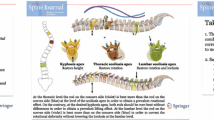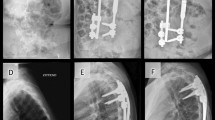Abstract
Purpose
A two-staged posterior correction, using a temporary magnetically controlled growing rod (MCGR), was employed to gradually and safely correct severe adolescent idiopathic scoliosis (AIS). The aim of the study is illustrating the results of this procedure.
Methods
A retrospective review of a consecutive series of 17 severe AIS. The first surgery was a posterior release (multiple Ponte osteotomies) with implant of pedicle screws and MCGR on the concave side of the curve. In post-operative days, a distraction was applied with MCGR, which allowed to obtain a total mean lengthening of 2 cm in about 2 weeks, with no complications arising. In the second posterior surgery, MCGR was removed and the definitive rods were applied for final fusion. The mean pedicle screws density was 93.3% (85–100). The extension of the final posterior fusion-instrumentation was of 13.8 levels (12–15).
Results
At an average follow-up (FU) of 2.9 years, the main scoliosis curves from average pre-operative Cobb angle of 98.2° (91°–138°) bent down to 38.3° (35°–76°) after definitive fusion (p < 0.05); at last FU, the overall correction was 58.7% (50.4–71.2), with an average correction loss of 2.1° (1.5°–3.1°). At last FU, no complications were reported.
Conclusions
Gradual traction with MCGR in severe AIS proved to be a safe method to achieve progressive curve correction before posterior final fusion, with no neurologic complications associated to more aggressive one-stage surgeries. In a staged approach, MCGR appears as an alternative to halo traction, avoiding frequent traction-related complications.



Similar content being viewed by others
References
Korovessis P (1987) Combined VDS and Harrington instrumentation for treatment of idiopathic double major curves. Spine 12:244–250. https://doi.org/10.1097/00007632-198704000-00009
Shufflebarger HL, Grimm JO, Bui V et al (1991) Anterior and posterior spinal fusion. Staged versus same-day surgery. Spine 16:930–933. https://doi.org/10.1097/00007632-199108000-00011
Savini R, Parisini P et al (1989) The surgical correction of severe vertebral deformities by combined anterior and posterior instrumentation. Prog Spinal Pathol 4:211–221
Suk SI, Chung ER, Kim JH et al (2005) Posterior vertebral column resection for severe rigid scoliosis. Spine 30:1682–1687. https://doi.org/10.1097/01.brs.0000170590.21071.c1
Lenke LG, Sides BA, Koester LA, Hensley M, Blanke KM (2010) Vertebral column resection for treatment of severe spinal deformity. Clin Orthop Relat Res 468(3):687–699. https://doi.org/10.1007/s11999-009-1037-x
Buchowski JM, Bhatnagar R, Skaggs DL et al (2006) Temporary internal distraction as an aid to correction of severe scoliosis. J Bone Joint Surg Am 88-A 9:2035–2041. https://doi.org/10.2106/JBJS.E.00823
Hui-Min H, Hua H, Hai-Ping Z et al (2012) The impact of posterior temporary internal distraction on stepwise corrective surgery for extremely severe and rigid scoliosis greater than 130°. Eur Spine J. https://doi.org/10.1007/s00586-015-4013-z
Cheung JP-Y, Samartzis D, Cheung KM-C et al (2014) A novel approach to gradual correction of severe spinal deformity in a pediatric patient using the magnetically-controlled growing rod. Spine J 14(7):e7–13. https://doi.org/10.1016/j.spinee.2014.01.046
Aldeeri R, Almansour H, Kentar Y et al (2018) Magnetically controlled growing rods for rigid scoliosis. Der Orthopade 10:867–870. https://doi.org/10.1007/s00132-018-3631-7
Lenke L, Betz R, Harms J et al (2001) Adolescent idiopathic scoliosis: a new classification to determine extent of spinal arthrodesis. J Bone Joint Surg Am 83:1169–1181
Cobb JR (1948) Outline for the study of scoliosis. AAOS Instr Course Lect 5:261–275
Kim YJ, Lenke LG, Bridwell KH et al (2004) Free hand pedicle screw placement in the thoracic spine: is it safe? Spine 29:333–342. https://doi.org/10.1097/01.brs.0000109983.12113.9b
Kabins MB (2004) Point of view. Spine 29:342. https://doi.org/10.1097/01.BRS.0000109984.65138.0C
Di Silvestre M, Parisini P, Lolli F et al (2007) Complications of thoracic pedicle screws in scoliosis treatment. Spine 32:1655–1661. https://doi.org/10.1097/BRS.0b013e318074d604
Ponte A, Orlando G, Siccardi GL (2018) The true ponte osteotomy: by the one who developed it. Spine Deform 6(1):2–11. https://doi.org/10.1016/j.jspd.2017.06.006
Sucato DJ (2010) Management of severe spinal deformity: scoliosis and kyphosis. Spine 35(25):2186. https://doi.org/10.1097/BRS.0b013e3181feab19
Akbarnia BA, Cheung K, Noordeen H et al (2013) Next generation of growth-sparing techniques: preliminary clinical results of a magnetically controlled growing rod in 14 patients with early-onset scoliosis. Spine 38:665–670. https://doi.org/10.1097/BRS.0b013e3182773560
Sponseller PD, Takenaga RK, Newton P, Boachie O, Flynn J, Letko L, Betz R, Bridwell K, Gupta M, Marks M, Bastrom T (2008) The use of traction in the treatment of severe spinal deformity. Spine 33:2305–2309. https://doi.org/10.1097/BRS.0b013e318184ef79
Park DK, Braaksma B, Hammerberg KW, Sturm P (2013) The efficacy of preoperative halo-gravity traction in pediatric spinal deformity the effect of traction duration. J Spinal Disord Technol 26:146–154. https://doi.org/10.1097/bsd.0b013e318237828c
Koptan W, ElMiligui Y (2012) Three staged correction of severe rigid idiopathic scoliosis using limited halo-gravity traction. Eur Spine J 21:1091–1098. https://doi.org/10.1007/s00586-011-2111-0
Yang C, Wang H, Zheng Z et al (2017) Halo-gravity traction in the treatment of severe spinal deformity: a systematic review and meta-analysis. Eur Spine J. https://doi.org/10.1007/s00586-016-4848-y
Savini R, Parisini P, Corbascio M et al (1977) Halo-traction associated with kinesiotherapy in the corrective treatment of scoliosis with severe respiratory insufficiency. Chir Organi Mov 63(4):353–360 (PMID:872682)
Clark JA, Hsu LCS, Yau AC (1975) Viscoelastic behavior of deformed spines under correction with halo pelvic distraction. Clin Orthop 110:90–111. https://doi.org/10.1097/00003086-197507000-00014
Xie JM, Zhang Y, Wang YS et al (2014) The risk factors of neurologic deficits of one-stage posterior vertebral column resection for patients with severe and rigid spinal deformities. Eur Spine J 23(1):149–156. https://doi.org/10.1007/s00586-013-2793-6
Funding
There is no funding source for this article.
Author information
Authors and Affiliations
Corresponding author
Ethics declarations
Conflict of interest
The authors declared that they have no conflict of interest.
Additional information
Publisher's Note
Springer Nature remains neutral with regard to jurisdictional claims in published maps and institutional affiliations.
Rights and permissions
About this article
Cite this article
Di Silvestre, M., Zanirato, A., Greggi, T. et al. Severe adolescent idiopathic scoliosis: posterior staged correction using a temporary magnetically-controlled growing rod. Eur Spine J 29, 2046–2053 (2020). https://doi.org/10.1007/s00586-020-06483-8
Received:
Revised:
Accepted:
Published:
Issue Date:
DOI: https://doi.org/10.1007/s00586-020-06483-8




